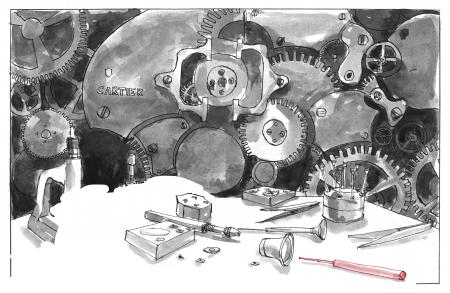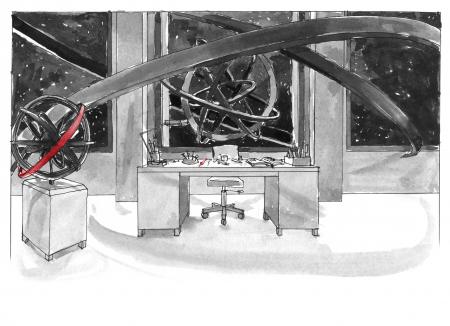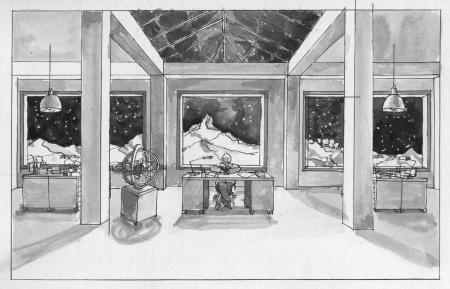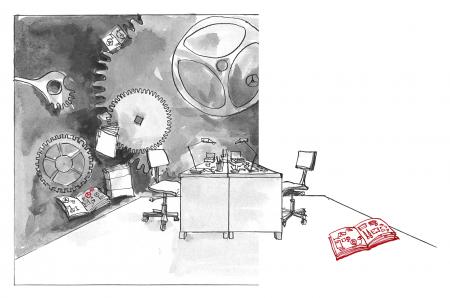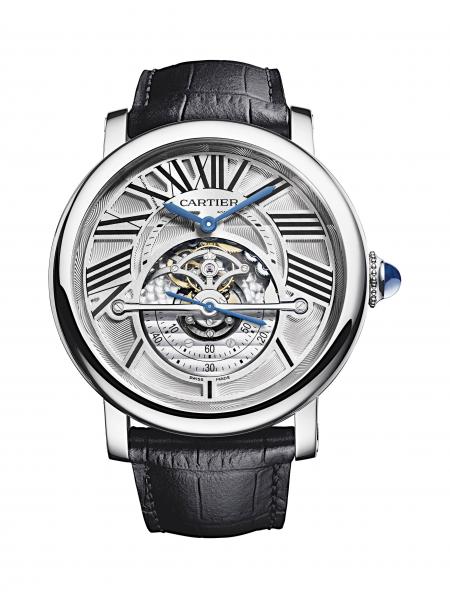Cartier : Watchmaking Expertise
At Cartier, time dreams, appears and vanishes, a material in its own right to be transformed. Time is hypnotic, a pretext for the creation of incredible timepieces. Miracle’ Magic’ For Cartier timepieces, time is much more than it seems, a mystery here, a fantasy there. The questions are in the surprise. Where is the mechanism’ What is the trick that makes the hands go round’ Where is time hidden’ Is it a ring’ A watch’ The answer is in the question, hidden beyond the technical skill, the creative mastery, the desire to bring illusion and duality into the magnetic field of watchmaking.
It all began in 1888, with the mention of the first wristwatches in Cartier’s ledgers. At the same time, a large number of pocket and chatelaine watches. Then in 1912 the first mystery clocks were created: “miracles of watchmaking”, the gazette said, marvelling at clocks whose hands seemed to float in rock crystal, totally unrelated to the movement. The story continues through two timepiece collections, from mystery to fantasy, allegories of an exquisite time when forms went into freestyle; an unpredictable time when watches went from jewel to brooch; a mysterious time when the tourbillon escapement in the Rotonde de Cartier watch was displayed in utter transparency, as though suspended weightless on the face.
It was a jewellery and watchmaking challengeinvolving such technical complexity and a host of professions – 150 in all – that only the utmost expertise would do. From the goldsmith to the enamellist, the lapidary to the watchmaker and the engraver to the jeweller, a chain of craftsmen linked by the kind of excellence that commands a tortoise whose gemstone shell shields the hours, or has a diamond-studded phoenix oscillate in rhythm with the ticking of the watch.
Nothing seems impossible, like the inventiveness of imagining starstruck mystery clocks, two timepiece UFOs in obsidian or agate marquetry that renew the genre, refreshing the fascination for an enigmatic time to which Cartier holds the secret.
CREATING A MOVEMENT
Every year, the Cartier Manufacture introduces new complications for its timepieces. A Fine Watchmak-ing movement is designed over the course of a long,complex and demanding process that couples human expertise with the latest technology. A complication movement takes years to perfect, and is the responsibility of watch designers who work in conjunction with a host of expert craftsmen employ- ing dozens of artisanal methods. The design and man-ufacture of a Cartier Fine Watchmaking movement calls for dual talents: an absolute mastery of technique coupled with a ?nely honed sense of elegance.
It all starts with an idea. The designers outline the concept in freehand, sketching the bases of the mechanism and ?nishes. These ?at drawings of the movement are developed into three-dimensional designs for each piece, checked by the watchmakers for feasibility. The functionality of the movement must be checked prior to producing a large mock-up. Working prototypes can then be built and tested for approval.
Rotonde de Cartier Astrorégulateur 9800 MC Watch
—
Case in niobium-titanium Cartier Manufacture mechanical self-winding movement, Calibre 9800 MC, escapement mounted on a micro rotor which counteracts the pull of gravity in upright positions.
Casing diameter:
15 ½ lines, i.e. 35.2 mm
Thickness:10.1 mm
Number of jewels:43
Number of parts:281
Balance:21,600 vibrations / hour
Power reserve of approx. 54 hours
Individually numbered movement
MANUFACTURING OF MINERAL CRYSTALS
Maison Cartier, maker of shaped watches, manufactures its own mineral crystal to ensure creativity remains entirely unfettered. Crystals are designed with masterful expertise in a variety of complex shapes to ?t the Crash watch, the Tank Américaine watch or the Tonneau watch.
Each crystal is worked manually to obtain the perfect curve by heating with a gas torch at up to 600°C; the expert craftsman visually judges the shape by the re?ections appearing on the glass. The outline of the mineral crystal is then polished by hand to create smoothly rounded edges and to ensure that it ?ts perfectly into the case.
MOVEMENT DECORATION AND ASSEMBLY
The stunninghand-?nishing of Fine Watchmaking movements gives these timepieces their unique value. Prior to ?nal assembly, each component of the movement is hand-?nished by craftsmen using specialised tools and traditional techniques. The precision of this decoration, whether hidden or directly visible to the eye, is a creative feat in itself. On a scale of miniscule proportions, the bridges are chamfered with a burnisher, the sides are gently ?led without interfering with the polish of the corners, and the surfaces of certain parts are given a mirror polish. A single component may require more than fifteen hours of work to finish. In the case of a skeleton watch – an architectural work in miniature – the delicacy and complexity of work is unrivalled.
These timepieces are designed to expose the beauty and complexity of the movement and showcase the art of the master decorator.
Fine Watchmaking timepieces are the exclusive domain of the most experienced master watchmakers: indeed, a thorough knowledge of the function of each component is required to assemble a complications movement. Through more than a decade of training and unique experience, the master watchmaker acquires the skill and insight required to assemble and regulate a complications timepiece from start to ?nish.
Gears, jewels, escapement, screws and bridges are assembled with the utmost order and precision to ensure the movement works ?awlessly.
Rotonde de Cartier Skeleton Flying Tourbillon Watch
—
Case in 18K white gold Cartier Manufacture mechanical movement with manual winding, calibre 9455 MC, certi?ed with the “Poinçon de Genève”, ?ying tourbillon, skeletonised bridges in the shape of Roman numerals.
Casing diameter:
15 ¾ lines, i.e. 35.5 mm
Thickness:5.63 mm
Number of jewels:19
Number of parts:165
Balance:21,600 vibrations / hour
Power reserve: approx. 50 hours
Individually numbered movement
“Poinçon de Genève” movement
MANUFACTURING OF HANDS
The delicate, tiny hands call for exceptional skill, dexterity and precision. Hands can take a range of forms including sword, apple, diamond or hammer shapes, to name but a few.
Each hand is cut with a high-precision press, sorted manually one by one prior to being oven-?red at 340°C to create the beloved Cartier blued-steel ?nish. Should the ?ring time or temperature be miscalculated, the colouring process must be repeated.
THE ART OF THE JEWELLER
Inspiredby travels real and imaginary, the Maison Cartier has tamed a marvellous menagerie all its own, over which the majestic panther presides.
Matter takes shape and comes to life when met with absolute mastery of technique, high-precision handiwork and constant attention to detail. The jeweller works as a sculptor, melting down gold and platinum, mixing alloys and fashioning metals, and offering unique and essential insight into the choice of gem, sizes and calibrations. The gem-setter steps in to dress the creature in a colourful precious coat. The transformation takes place under the precise hand of the master jeweller and a perfectly judged selection of pre-calibrated gems.
Diamonds, emeralds and sapphires now become part of the creation. The play of light and positioning are dictated by the size and make-up of each quintessentially precious stone, which the master craftsman handles with unrivalled ?nesse.
Tiger Mask Secret Watch
—
18K rhodium-plated white gold
1,453 brilliant-cut diamonds for 15.02 carats
Quartz movement
MANUFACTURING OF DIALS
The dial makerdraws on a whole domain of expertise, making use of trade secrets which have been passed down over many generations.
Cartier has become a master of the art of guilloché by building an extensive portfolio of objects featuring enamel on a guilloché background. This technique decorates the dials of many timepieces. A Cartier dial is instantly recognisable thanks to the trademark rail track, Roman numerals and secret signature. Dials offer in?nite potential for creativity, adorned with silvered, sunray, grained, or ?inqué effects, set with stones or inlaid with mother-of-pearl.
ENAMEL MINIATURE PAINTING GRISAILLE ENAMEL AND GRANULATION
Cartier showcases a wealth of craftsmanship within the tiny frame of its dials: enamel, granulation and marquetry are among the traditional techniques passionately revived by Cartier.
Enamel miniature painting is one of the rarest and most precious of these artisanal techniques. Forty hours of exceptionally precise work are needed to complete a single dial. A plate of gold is covered by four coats of enamel acting as the backdrop for the illustration. The motif is painted entirely by hand in ?ve or seven coats on the ?rst layer of enamel, using a very ?ne brush. A ?ux is applied in three coats to give the dial its depth and provide protection. Each coat is ?red to at least 750°C to yield the required shade.
The art of grisaille enamel is named for its grey palette, completely absent of colour. The artist covers the dial with a coat of glossy black enamel, ?res it in the oven, then paints a design step by step in Limoges white using a small brush. Working like a painter, the enameller gives depth to the white and brings out shadow, contrast and the play of light. With a special tool, the white is scratched to accentuate the relief in the design. Over the course of 40 hours of work and six to eight ?rings, the motif gradually emerges.
The fascinating gold-working technique of grisaille dates back almost 5,000 years, when it was made famous by the craft of granulation. The master watchmaker creates small balls from gold wire that is cut and heated in a ?ame. The balls are meticulously assembled and fused onto a gold plate to build the relief of the motif. The result is spectacular every time.
Les Indomptables de Cartier Collection
—
Multiple wear options:
separable frog decor brooch
Case in 18K pink gold
Case set with 214 brilliant-cut
diamonds for 2.69 carats
Dial in 18K white gold with
enamel miniature painting
Dial set with 11 brilliant-cut
diamonds for 0.15 carats
and 7 sapphires for 0.27 carats
18K pink gold frog decor brooch
set with 67 brilliant-cut diamonds
for 1.18 carats, 3 moonstones
for 6.04 carats, 8 sapphires
for 1.54 carats and 2 emeralds
for 0.04 carats
Quartz movement
Limited and numbered edition
